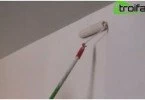How and how to paint the walls in the apartment
The beauty and comfort of the house is extremely expensive for every housewife. The more own forces are invested in the creation of this same comfort, the more valuable labor is valued. But if decorating a table with a vase of flowers is easy and simple without special knowledge and skills, then painting the walls of an apartment at random is a pointless waste of time and money. All the same, it will become a “bear labor”, which will need a quality alteration. Before you paint the walls in the apartment, you should understand the essence of the matter and take into account all the subtleties and nuances. Only then will the walls delight the eye and enrich the interior of the room.
Content
- The choice of paint for walls
- Preliminary stage – thorough preparation
- Proper wall painting
- Use of water based paint
- Brush application
- Roller dyeing
- Airbrush: combine speed and volume
The choice of paint for walls
Everyone understands that the word “paint” has a common basis with beauty. Indeed, the paint brings a new breath to the apartment and gives novelty and originality. For internal painting, appropriate compositions are used. First of all, paint for internal work should be safe for health. And also you need to choose quick-drying compositions without an unpleasant odor, easy to apply, not requiring professional skills and equipment.
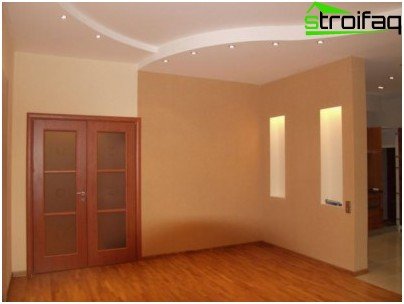
Proper painting is an excellent result.
Materials for painting walls should have higher quality indicators than paints for ceilings. This is because the surface of the walls is more accessible. Of particular relevance is the hiding power indicator, that is, the minimum amount of paint that is necessary for uniform painting of the original color. It is this value that determines the consumption of paint and its efficiency.
To calculate the amount of paint, the room is measured and the area is calculated. In this case, do not subtract the area of windows and doors – an excess supply of paint does not hurt. And if you buy the paint “to zero”, then it may not be enough, and then you have to choose the tone; also take into account the number of layers.
An important aspect in the choice of the coloring composition is moisture indicators. For wet rooms, paints with a high degree of moisture resistance and protection against mold should be purchased. Well, children’s rooms without fail are painted only with hypoallergenic and environmentally friendly paints..
Preliminary stage – thorough preparation
Before starting the painting, it is necessary to free the room from furniture, if possible, and it is advisable to concentrate the remaining things in the center of the room and cover with a dust film.
Do not forget about respirators, goggles and protective gloves when preparing the surface. Soda and sodium phosphate, even in a dusty state, can cause allergic irritations.
Walls need cleaning, leveling, removing the old layer of paint or wallpaper, puttying cracks and conducting high-quality priming. After drying the primed walls, it is necessary to process the rough areas with sandpaper.
Important: if the surface of the sandpaper is covered with dust and has lost grain, it is time to replace it with a new piece of sandpaper.
After grinding is completed, the entire primed base is wiped with a damp cloth to remove dust. The boundaries of the area to be painted are indicated by masking tape, and also it covers the door and window frames adjacent to the walls..
Proper wall painting
So, the front of the work is prepared, but how to paint the walls correctly, because one wrong brushstroke and appearance will no longer be as beautiful as we would like. Therefore, you must adhere to proven recommendations and get an excellent result at the finish line..
The paint must be applied in a uniform layer, the movements should be first in one direction, and then perpendicular to the first direction. Also, the surface should be shaded to obtain uniformity. Otherwise, excess paint will drain, and the wall will have an unpleasant appearance. For the same reason, avoid using too liquid paint and apply it in several layers..
For painting a large area, it is advisable to preliminary divide the wall into small sections, they can be limited by trims or seams.
Use of water based paint
Decorative wall decoration with water-based paint is a common way to give your home an elegant look. It is characterized by a rich variety of tonal colors to create walls of any color. And this is the implementation of the most unprecedented fantasies.
Water emulsion – paint, which is based on emulsion and water. It can be bought at any hardware store. For dilution, add water and then mix thoroughly.
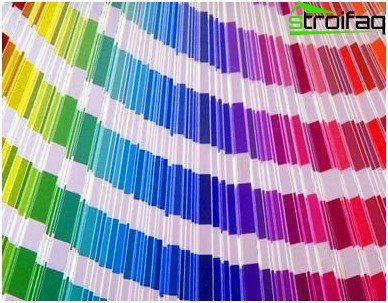
A wide variety of colors used to give a shade to water-based paint
Actually, water-based paint is white, to obtain a certain shade color is added to it, which sets the tone. Color saturation depends on the amount of color added to the paint.
The color is mixed until a consistency is obtained without streaks, this can be done manually or with a drill with a whisk.
Important: water-based paint is diluted with a color scheme immediately to the entire area. If there is not enough paint, achieving a similar tone is extremely difficult..
Brush application
How to paint the walls with a water-based paint brush, and what rules should be followed? For such painting it is necessary to use a wide brush, preferably with sizes of 100-125 mm. The brush is immersed in the paint so that only a third of the bristles are covered, then the brush is pressed against the wall of the container to remove excess.
Painting the walls should begin from above, the paint is applied with short strokes that overlap each other. It is advisable to process a surface of about 1 sq. M in one go. m, and the new section should overlap the previous, but only along the still wet edges.
The paint is applied successively until the wall is painted. A break is best done at the end of processing one wall, because a change in tone will be striking.
Roller dyeing
Application of water-based paint with a roller is a quick way to process a large surface. But in this case, it will be necessary to apply more layers, since the paint is distributed with a thinner layer using the roller.
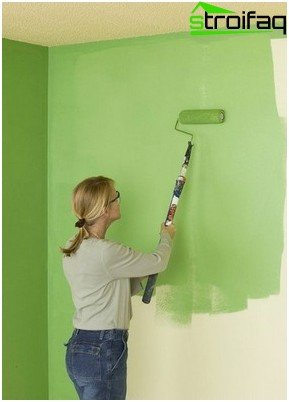
Painting the walls with an extended handle roller
Important: the use of a roller with a long handle greatly facilitates the work.
First, the pallet is filled with paint (about a third), the roller is lowered into the paint and rolled along the ribbed bottom of the pallet back and forth. Such movements ensure uniform distribution of paint on the roller.
Important: the roller axis must not be immersed in paint..
With careful movements, paint is applied to the substrate. Work should start from the top of the wall, while the roller moves like a W-shaped pattern. Well, do not forget about the overlap of new strokes on the edge of an already painted surface.
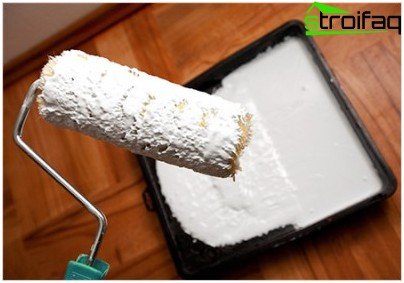
When painting with a roller, the contractor will need a pallet with a raised bottom, it is necessary for uniform distribution of material on the working part of the painting tool
Upon completion of work, it is rational to leave the roller in a bucket of water overnight. This will make it possible to reuse it when necessary to apply a second layer..
Then the masking tape is removed, and the borders are tinted with a thin brush.
Airbrush: combine speed and volume
With this tool, work will go much faster, large surfaces of the walls will be evenly painted, including hard-to-reach spots (behind the radiator). This work should be carried out in a ventilated, dry room..
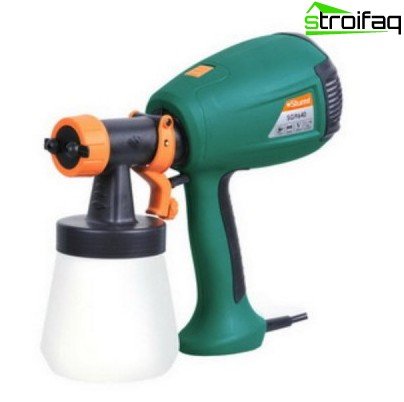
Airbrush – quick staining
Important: there should be no strong air currents in the room so that the coloring compound does not fall on surrounding objects.
Before painting, it is necessary to check the operation of the spray gun on a rough surface, while the paint should be used liquid and uniform.
Brick wall painting
It makes no sense to argue, the brick itself is a beautiful building material that does not need additional decoration. But this applies more to the outer wall. And if the room has a wall of this material, then it must be painted. The brick wall will have a more decent appearance, and will also become durable and waterproof. The process is complex, since the surface of the brick wall is heterogeneous, therefore, preliminary preparation is necessary.
Firstly, a brick wall must be given a homogeneous structure. If you ignore this process, the paint will drain or crack after a while. So, first the wall is inspected, the cracks found are cleaned of debris and repaired with cement or special latex paint. Small cracks are smeared with a layer of plaster, the masonry joints are cleaned of mortar and also plastered.
As for possible lime stains, it is necessary to get rid of them, because the paint in these places will not adhere well. And these are peculiar signals about water falling on the wall, the reason for this phenomenon must be eliminated.
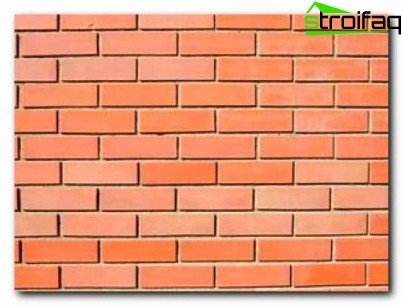
Brick wall before painting requires competent preparation
Secondly, the brick wall should be perfectly smooth. This can be achieved by using a stiff wire brush. If the wall is very dirty, then it should be treated with solvent and remove all traces of the previous painting or whitewashing. Then the wall should dry thoroughly (several weeks) and only then it will be primed.
Primer is an important process, the main intermediary for a good adhesion of the paint wall. Therefore, her choice should be reasonable and deliberate: the primer must penetrate deeply, repel water and prevent the destructive effect of moisture. It is applied with a layer of 1-2 mm, this is the best option for the best smoothing of the wall.
Tools for painting a brick wall need similar ones, that is, brushes and a roller, only they should be more rigid. The brick wall has a rather rough surface, so the tool wears out faster.
How to paint a brick wall, and what parameters should be followed when choosing a paint? Silicate, polymer and cement paints are used to paint brick walls. These are the most durable and lasting paints. In addition, the solvent should not be part of the paint – it will dry for a long time.
Acrylic paint is a latex type, it is characterized by high moisture resistance, strength and excellent hiding properties. It is with such a water-based paint that it is best to paint a brick wall.
And another important point, the fact is that retrostyle is in fashion today. For its design uses the natural texture of materials. In this case, an unplastered, bare brick wall in the apartment is allowed. In this case, it is not necessary to pre-treat the walls, because the material should not be hidden, but rather, the brick should be emphasized. The decorative properties of the brick are complemented by simple painting.
Using coloring compositions of different tonality, you can create a unique pattern on the wall surface.
After properly executed painting, the room becomes completely different, fresh and clean. You can paint the walls with your own hands, and go to a restaurant for the money saved and mark the end of the repair.



